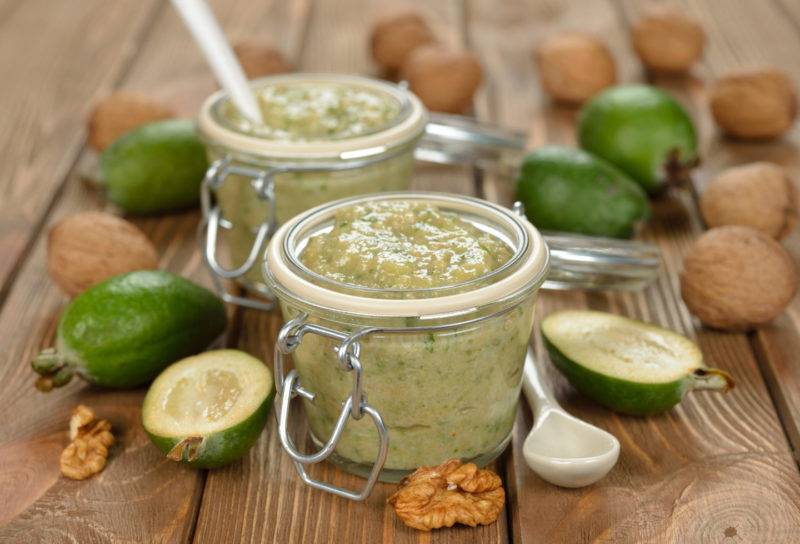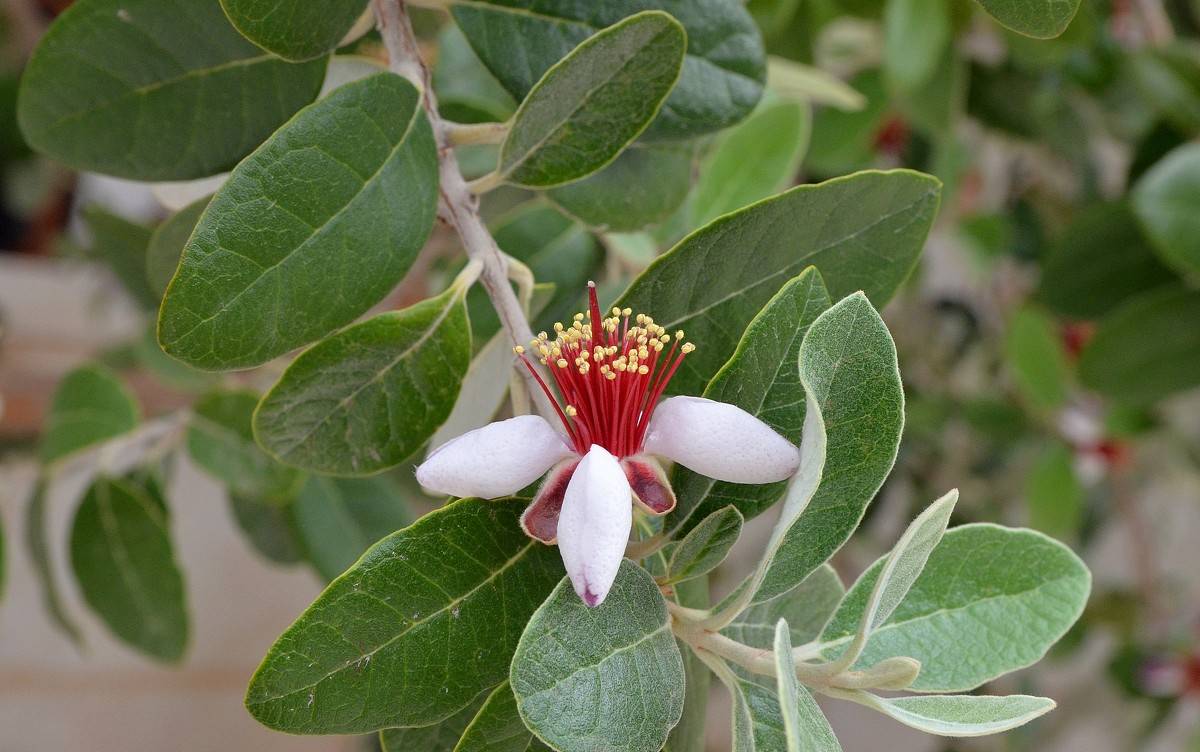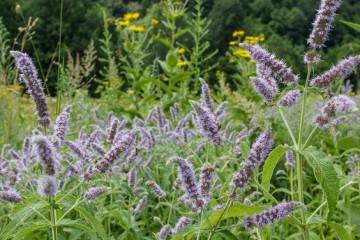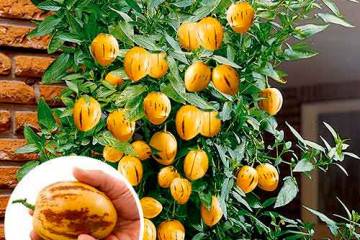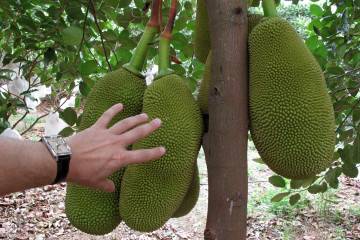Feijoa - what is this tree, what does it look like
Content:
The tropical plant feijoa, or akka, is very popular among Russian gardeners. Thanks to the emergence of hybrid varieties bred by breeders, trees can be grown even indoors.
Feijoa: description of the plant and fruits
Feijoa - what is it? The fruits of this exotic plant can often be found in stores in the fall. Outwardly, they look like a large gooseberry with a thick dark green peel with a bluish tint. The inside is jelly-like and contains small bones. The fruit tastes a bit like pineapple and kiwi.
Feijoa is a tree or shrub named after its discoverer, a scientist of Portuguese origin. This is a short evergreen plant, covered with a rough brown bark. It originally grew in the subtropical region of South America. Only a couple of centuries ago, it was brought to Europe. Later, this exotic plant spread to other parts of the world, including Russia.
Not everyone knows what feijoa is. Its large size can be confusing. Is feijoa a fruit or a berry? Many find it difficult to answer this question.
Despite the fact that the fruits of this plant are about the size of a medium-sized apple, biologically, feijoa is a berry. They are widely used in salads, marinades, baked goods. You can also cook jam or compote from berries. Feijoa fruit is completely edible - both the pulp and the peel are eaten. The recommended daily allowance is approximately five fruits.
Useful properties of fruits
The benefits of feijoa cannot be underestimated - this berry contains many useful substances for humans. It is easily absorbed in the body and helps to restore immunity, increase hemoglobin levels, and prevent heart and vascular diseases.
The composition of the fruit includes such useful substances:
- iodine;
- folic and malic acid;
- phytosterols;
- potassium, zinc, phosphorus, magnesium, calcium;
- antioxidants;
- essential oils;
- vitamin B1, B2, B3, B5, B6, C, PP.
The fruits can be used not only internally, but also externally. Homemade anti-aging and nourishing face masks are prepared from the grated peel and pulp. Shredded bones are a natural exfoliant that can be used as a scrub.
Contraindications to use
Feijoa can cause a negative reaction of the body in the following cases:
- Spoiled fruit. Fresh berries should not be small or soft. In the first case, there is a risk of acquiring an immature fruit that will be tasteless and tough, in the second - stale. It is important to check the peel for rot spots - such a fruit can cause significant harm to the body.
- Sensitive or damaged tooth enamel. The berry contains several types of acids that can negatively affect tooth enamel.
- The presence of diabetes mellitus. In the case of this disease, a doctor's consultation is required, since the fruits contain more sugar.
- Cholelithiasis or urolithiasis.
- Eating with dairy products. May cause severe stomach upset.
- Children under the age of 5 are not recommended to eat these berries.
- Allergic reaction.
Popular feijoa varieties
To choose the right plant for growing, it is worth studying the features of all varieties.
Kulindzh variety
The self-fertile feijoa variety does not need pollinators during flowering. This variety is native to California. Ideal for indoor cultivation. Fruits are slightly odorless, small in size, weighing up to 60 g.
Choisean variety
The second known variety is Choyoseana. It is considered early ripening, but its yield is less stable. The berries are round, with a smooth dark green shell, small in size up to 7 centimeters.
Superba variety
The fruits of this variety are very fragrant, elongated oval. Weight can vary from light to medium, depending on the conditions in which the plant is kept. Some berries can weigh up to 100 grams.
Growing feijoa at home on a windowsill
Exotic fruits can be obtained at home, but for this you need to follow certain rules.
Illumination and temperature conditions
Lighting levels are the main factor to consider when growing feijoa. Where does it grow best? This plant needs a lot of bright sunlight, so it is best to place the container with the bush on the southern windowsill. Under conditions of short daylight hours, you need to purchase additional lighting lamps for it. Without enough light, the feijoa will not only fail to bear fruit, but may also die.
The feijoa tree has an average degree of frost resistance. In the cold season, it can tolerate frosts up to 10 degrees. However, low temperatures can adversely affect plant health. In winter, a temperature of about 15 degrees is suitable for him, in summer - 20-25 degrees.
Air humidity and watering
Feijoa belongs to moisture-loving plants, so you need to constantly monitor the level of soil moisture. Watering is carried out from above. A spray bottle and a warm shower can be used as additional humidification. Water for irrigation should be settled, at room temperature. An hour after water procedures, it is important not to forget to drain the water from the pan - this way you can protect the root system of the tree from rotting.
You can determine whether a plant needs watering by looking at the top layer of the soil. A dried crust on the surface of the earth will indicate the need for moisture. In winter, watering usually needs to be done less frequently.
This exotic shrub prefers high humidity. In dry weather and when the central heating is running, it will need additional spraying.
Soil composition and feeding
In the wild, this shrub is undemanding to the soil. But feijoa, growing in poor soil at home, has nowhere to take useful substances. The best option would be to mix several types of soil - sand, humus, manure and turf. The latter should make up most of the soil.
In the spring, feijoa is additionally fertilized every ten days. For this, you can use both mineral and organic fertilizers.
Experienced gardeners prefer to apply top dressing in a specific sequence:
- nitrogen-based fertilizer - poultry or cow dung;
- potash - wood ash or cement dust;
- superphosphate.
Flower container size
Choosing the right pot is an important consideration when growing feijoa. Common clay pots will not work as the porous material will quickly evaporate moisture. It is better to use a plastic or enamel vessel as a container for the bush.
If a pot with a diameter of 15 centimeters is enough for seedlings, then an adult plant will need a larger space - at least 40 centimeters. There must be drain holes at the bottom of the vessel.
Pruning and replanting
The feijoa crown needs periodic pruning. First of all, the lowest branches that are not able to bloom or produce a crop are removed. Sick, competing branches or branches that have grown at a large angle are also removed.
Not everyone knows what a feijoa looks like in the wild. Its trunk is capable of growing more than 6 meters in height, therefore, when grown indoors, the top must be plucked - it is best to do this in the fall. Before the procedure, the pruning shears blades are treated with a disinfectant. For disinfection fungicidal solution.
The interval between replanting feijoa depends on the age of the tree itself. Young plants up to three years old are transplanted every year, and older ones - once every few years. In the process of moving the flower to a new place, the earthen lump at the roots is left intact, and additional soil is added to the new pot.
Feijoa bloom, how many times a year
It is important to know how feijoa blooms - caring for this shrub is highly dependent on the stage of the life cycle.
Feijoa bloom begins in the last month of spring and lasts about three weeks. The flowers of this plant are pale pink, the size of a five-ruble coin. They can be either single or combined into small inflorescences. Each flower consists of four petals and a large number of stamens, painted in contrasting red. The period when feijoa ripens begins in autumn, closer to winter.
How to propagate a tree
You can grow feijoa at home using seeds or cuttings. The second option is considered the easiest and most effective. You can purchase ready-made material at a gardening store, or get the seeds yourself from the pulp of the fruit.
Using cuttings
Reproduction by cuttings is the most affordable and reliable way to grow feijoa at home. Information about the ease of germination of the seeds of this shrub is nothing more than a myth.
Step-by-step description of the propagation process by cuttings:
- Several branches about 10 centimeters long are separated from an adult plant, and all the foliage is removed from them. You need to cut the branches at an angle.
- The cuttings are kept in Kornevin's solution for about 20 hours.
- After they are placed in the soil horizontally and watered with a weak solution of potassium permanganate.
- Cover the pot with cuttings with foil or glass, and leave until new leaves appear. The room temperature should not drop below 22 degrees Celsius. From time to time, you need to ventilate future feijoa bushes and moisten them.
After complete rooting, each plant is transplanted into a new pot. The duration of the formation of its own root system usually takes 1-2 months.
Feijoa seeds can be obtained directly from the berry itself. To do this, it is opened with a sharp knife, the seeds are washed and dried. They can be stored if the temperature is low enough - about 5 degrees Celsius.
The germination process with seeds is as follows:
- The seeds are laid out to a depth of about half a centimeter in the ground.
- The soil is moistened with a manganese solution and covered with foil.
- After about 20 days, new shoots should appear.They are thinned out, leaving the healthiest specimens.
- Grown plants are transplanted into different containers.
Possible problems in growing a tree
Feijoa trees have good resistance to disease and parasite infestations. However, they can fall prey to the false thyroid gland. These are very tenacious and dangerous pests. Their bodies are covered with a thick layer of wax protection. They often start on the outside of leaves or shoots, leaving traces that are visible to the naked eye. Outwardly, it looks like a whitish sticky coating. It poses an additional danger to the plant - fungi begin to multiply more actively in the sticky mass.
Once a week, a plant affected by the thyroid gland is treated with a soap solution and an oil-mineral based emulsion.
Feijoa is recommended for those who already have a little gardening experience. With proper care, this exotic plant from the subtropics is able not only to decorate any interior, but also to bring a harvest of healthy and tasty berries.
